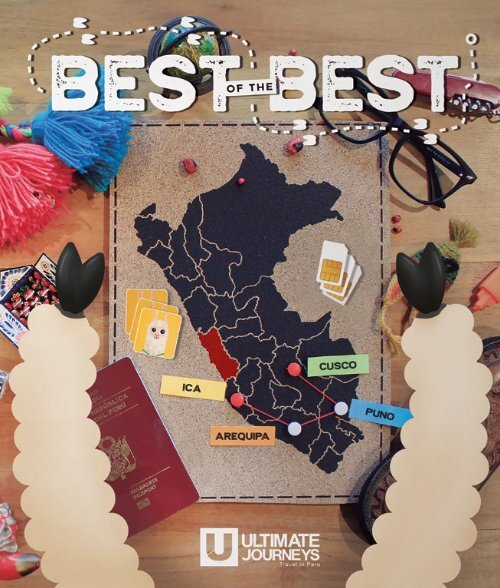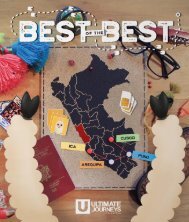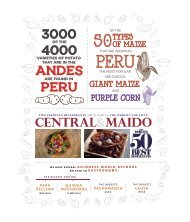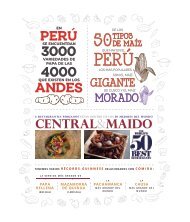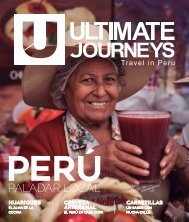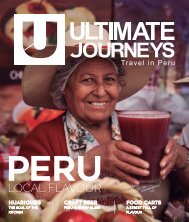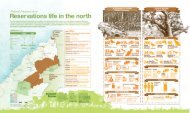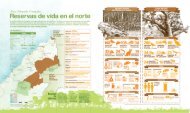Create successful ePaper yourself
Turn your PDF publications into a flip-book with our unique Google optimized e-Paper software.
1
2
Private sailing on Lake Titicaca, the world’s highest navigable lake.<br />
3
This edition of Ultimate<br />
Journeys - Travel in Peru was<br />
produced by LimaTours’<br />
marketing team.<br />
<strong>UJ</strong> GENERAL DIRECTOR<br />
Gerardo Sugay<br />
CONTENT DIRECTOR<br />
Gerardo Sugay<br />
Ana Paula Albín<br />
Ximena Arrieta<br />
GENERAL EDITOR<br />
Ximena Arrieta<br />
PRODUCT DESIGN<br />
Dafne Vargas<br />
COORDINATION<br />
Karla Huertas<br />
ART DIRECTOR<br />
LimaTours<br />
GRAPHIC DESIGN<br />
Sergio Salazar<br />
INFOGRAPHICS<br />
Sergio Salazar<br />
EDITORIAL STAFF<br />
Ximena Arrieta<br />
FOTOGRAFÍAS<br />
Archivo LimaTours<br />
@MatthewSchueller<br />
ROUTE<br />
This edition is an adventure through<br />
the south of Peru. Join us on a<br />
journey with Maca to discover<br />
fascinating places following a<br />
mysterious map.<br />
4<br />
Sergio Salazar<br />
PromPerú<br />
Intu<br />
1<br />
3<br />
COVER PAGE PHOTO CREDIT<br />
Sergio Salazar<br />
2<br />
Naomi Tamamoto
ica<br />
SAND, BEACH AND NATURE<br />
12<br />
14<br />
16<br />
18<br />
20<br />
BALLESTAS ISLANDS: A PLACE <strong>OF</strong> BIRDS AND SEA LIONS<br />
NASCA FROM <strong>THE</strong> SKIES<br />
<strong>THE</strong> FLAVOUR <strong>OF</strong> PISCO<br />
BETWEEN <strong>THE</strong> SKY AND <strong>THE</strong> DESERT<br />
IN <strong>THE</strong> TRACKS <strong>OF</strong> <strong>THE</strong> DAKAR<br />
AREQUIPA<br />
GASTRONOMY AND HISTORY<br />
puno<br />
nature and tradition<br />
26<br />
28<br />
30<br />
32<br />
34<br />
TASTING AREQUIPA<br />
A JOURNEY THROUGH TIME<br />
<strong>THE</strong> SILLAR ROUTE<br />
<strong>THE</strong> FLIGHT <strong>OF</strong> <strong>THE</strong> CONDOR<br />
NATURAL BONDING<br />
40<br />
42<br />
44<br />
46<br />
48<br />
EXPERIENCING LA CANDELARIA<br />
<strong>THE</strong> LIVING CULTURE <strong>OF</strong> TITICACA<br />
SOCCA, LAKESIDE TRANQUILLITY<br />
LLACHON, A LIFE EXPERIENCE<br />
<strong>THE</strong> TWO "PIETAS" <strong>OF</strong> LAMPA<br />
machu<br />
picchu<br />
64 <strong>THE</strong> LIVING MAGIC<br />
<strong>OF</strong> MACHU PICCHU<br />
CUSCO<br />
<strong>THE</strong> INCA EMPIRE<br />
54<br />
56<br />
58<br />
60<br />
62<br />
<strong>THE</strong> O<strong>THE</strong>R FACE <strong>OF</strong> SACSAYHUAMAN<br />
CUSCO BENEATH <strong>THE</strong> STARS<br />
SACRED VALLEY, <strong>THE</strong> HEART <strong>OF</strong> <strong>THE</strong> EMPIRE<br />
ANCIENT SCIENCE IN <strong>THE</strong> LABORATORIES <strong>OF</strong> <strong>THE</strong> ANDES<br />
HANAN PACHA, <strong>THE</strong> WORLD <strong>OF</strong> <strong>THE</strong> CONDOR
EDITORIAL<br />
DEAR TRAVELLER:<br />
Can we trust you with a secret? We have in our hands an ancient map, which our woolly friend Maca the<br />
Alpaca found hidden away among her family’s old books. It shows the way to a place of dreams, full of magic<br />
and tradition, surrounded by fantastic scenery and alive with ancestral energy.<br />
You are invited to go on an unequalled adventure with Maca in search of this mysterious world. The journey<br />
begins in Lima and heads south, threading its way through the sandy dunes of the Ica desert, with the dazzling<br />
wealth of Peru’s coastal waters and the pre-Inca cultures that thrived here. Further south, we will discover the<br />
colonial heritage that the Spanish left in Arequipa, a treasury of Vice-royalty architecture which provides the<br />
setting for a local cuisine which will excite your palate in every way.<br />
Continuing to the south and the Inca world begins to shine. First in Puno, a place of legend where according<br />
to tradition, the Inca founding fathers rose up out of the mystic waters of Lake Titicaca in search of the perfect<br />
foundation on which to build the capital of their Empire. Finally, we enter Cusco, the enchanted city of narrow<br />
cobbled alleyways, impressive stone-built walls and an ancient culture which still survives in the communities here.<br />
At every step, Maca will show you the best experiences to enjoy your time to the full, chosen to satisfy the<br />
tastes of every traveller: adrenaline junkies, fans of food, lovers of history, and those who seek close and<br />
meaningful contact with nature and local tradition.<br />
Let yourself be led by the hand (or hoof) of Maca, our local expert, and enjoy everything that our glorious<br />
Peru has to offer.<br />
Happy holidays and a fantastic 2020!<br />
Your friends at LimaTours<br />
Design and management of tour programmes, in all areas of the<br />
company (quotation, product design, suppliers management, Lima<br />
operations, billing and collection)
A U N I Q U E P L A C E<br />
F O R D E E P E N C O U N T E R W I T H Y O U R NAT U R E<br />
L I V E T H E P E RU V I A N A M A Z O N AT A N OT H E R L E V E L<br />
ECOADVENTURE<br />
BIRD AND DOLPHINS<br />
WATCHING<br />
EXPERIENTAL<br />
TOURISM<br />
SUSTAINABLE<br />
ACTIVITY<br />
PRIVATE<br />
RESERVE<br />
Telephone: +511 469 4521<br />
E-mail: reservas@pacayasamiria.com.pe www.pacayasamiria.com.pe
CURRENT ISSUES<br />
LimaTours<br />
PERU ONE <strong>OF</strong> <strong>THE</strong> <strong>BEST</strong><br />
SAYS CONDÉ NAST<br />
Art in Motion - Peruvian Edition is a new project from<br />
Belmond that will bring its guests closer to contemporary<br />
national culture through arts, design and food. The venue<br />
for this work was the Hiram Bingham train, which has been<br />
re-conceived by artist Fito Espinosa to evoke the natural<br />
world. The drinks menu has been recreated by Aaron Diaz,<br />
the mixologist of the popular bar Carnaval in Lima, and the<br />
food includes dishes prepared with local ingredients of the<br />
highest quality. Also, the uniforms of the staff have been<br />
revamped by fashion designer Jose Miguel Valdivia, taking<br />
inspiration from the outfits of Hiram Bingham himself<br />
during his expedition to Machu Picchu in 1911, though with<br />
a modern touch.<br />
Prestigious magazine Condé Nast Traveler has chosen Peru<br />
as one of the best countries in the world in its latest annual<br />
Readers Choice <strong>2019</strong>. More than 600,000 readers took<br />
part in the survey, rating their travel experiences around<br />
the world, and placing our country Peru in sixth place<br />
overall. In the survey, several Peruvian hotels were ranked<br />
in the top ten in South America: Aranwa Cusco Boutique<br />
Hotel (# 1), Aranwa Sacred Valley Hotel & Wellness (# 2),<br />
Country Club Lima (# 5), and Sumaq Machu Picchu Hotel (#<br />
9). In the resorts category, the Condé Nast readers chose<br />
Tambo del Inka, Luxury Collection Resort & Spa (# 5), Hotel<br />
Paracas, Luxury Collection Resort & Spa (# 8) and Aranwa<br />
Pueblito Encantado del Colca (# 9). Finally, the Belmond<br />
Andean Explorer was named the best train in the world,<br />
and the Belmond Hiram Bingham won fifth place.<br />
Medios<br />
ART IN MOTION COMES<br />
TO MACHU PICCHU<br />
NIGHTS <strong>OF</strong> PERUVIAN FLAVOUR<br />
IN <strong>THE</strong> WORLD<br />
Maido<br />
For the third year in succession, the restaurant Maido has<br />
been selected as the best in the region in the awards for<br />
Latin America’s 50 Best Restaurants, held in Buenos Aires,<br />
Argentina. Mitsuharu Tsumura, the Chef who fronts up<br />
Maido, received the award which places Maido as the top<br />
restaurant, once again ahead of Central and chef Virgilio<br />
Martinez, which took second place. Meanwhile, Peru was<br />
once again recognised as the world’s Leading Culinary<br />
Destination – for the eighth time – in the global edition<br />
of the World Travel Awards, the Oscars of Tourism. In the<br />
same awards ceremony, held in Oman, our country also<br />
triumphed in the category of Leading Cultural Destination<br />
and won Leading Tourist Attraction with Machu Picchu.
LimaTours<br />
LimaTours<br />
TWO NEW CREATIVE CITIES<br />
WERE CHOSEN BY UNESCO<br />
The selection of Peru as a location for great international<br />
sporting events distinguished <strong>2019</strong>. This year, our country<br />
was visited by thousands of sports fans of all kinds,<br />
beginning with the Dakar Rally in January, which took<br />
them through the fantastic landscapes of our coastal<br />
desert. In June, the Panamerican Games and the Para-<br />
Panamerican Games put Lima in the spotlight, as the city<br />
hosted the participants, their families and supporters.<br />
Finally, we close the year with Lima as the chosen venue<br />
for the final of the Copa Libertadores, South America’s<br />
international competition for soccer club sides. These<br />
events establishing Peru as a destination ready and able<br />
to hold such prestigious international competitions which<br />
promote foreign tourism and help the development of the<br />
industry within the country.<br />
NEW FIGURES<br />
FOUND IN NASCA<br />
Arequipa and Ayacucho have been added to Unesco’s<br />
Creative Cities, a group that aims to promote international<br />
collaboration between developing countries by<br />
establishing networks of creativity and culture. Arequipa<br />
has been selected in the category of “Gastronomy” for<br />
its contributions to Peruvian cuisine, while Ayacucho was<br />
chosen in the area of “Crafts and Popular Art” given that its<br />
handicrafts are the foundation of its economy and regional<br />
identity. The Unesco project of Creative Cities was set up<br />
in 2004 and now has 180 members around the world,<br />
focused on seven areas: Cinema, Music, Literature, Design,<br />
Digital Arts, Gastronomy, and Crafts and Popular Art.<br />
<strong>2019</strong> WAS PERU’S<br />
SPORTING YEAR<br />
On the 25th anniversary of the nomination of the Nasca Lines<br />
as a World Heritage Centre by Unesco, a new discovery puts<br />
the geoglyphs back in the headlines. After an investigation<br />
by archaeologists from the University of Yamagata in Japan,<br />
more than 140 new geoglyphs have been identified including<br />
both human and animal figures. To identify them, the<br />
scientists used fieldwork and advanced technology including<br />
satellite imagery, three-dimensional scanning and Artificial<br />
Intelligence. Masato Sakai, director of the investigating team,<br />
stressed the importance of the findings in enabling the<br />
recovery of the figures, which were found in poor condition,<br />
close to “a crisis of destruction”. Making them visible will allow<br />
them to be protected as national heritage.<br />
Medios
LIMA<br />
We head to the south of Lima, following the<br />
route on the map. After travelling for four hours,<br />
we reach Ica, an oasis set in the coastal desert,<br />
with something to suit everyone.<br />
Here you can discover the charms of this<br />
city and its surroundings. It has both history<br />
and mystery, in contact with nature on all sides,<br />
offering both adrenaline adventures and great food<br />
and drink experiences. All this with a warm and sunny<br />
climate, perfect for visiting at any time of the year.
EXPERIENCES<br />
The Ballestas Islands: a place of BIRDS and SEA lions<br />
Nasca from the skies<br />
The flavour of Pisco<br />
Between the sky and the desert<br />
In the tracks of the Dakar
LimaTours
ICA: SAND, BEACH AND NATURE<br />
Ballestas Islands : a place<br />
of BIRDS and SEA lions<br />
Nature and Experiential<br />
4 hours AM Upon Request<br />
If we ask you to think of a penguin, what first comes to mind?<br />
Ice, perhaps, at the north or south pole, or somewhere very<br />
cold. And you are right. But if we tell you that you can find<br />
penguins in the the desert, would you believe us?<br />
LimaTours<br />
The Ballestas Islands are a beautiful sight for lovers of the<br />
sea, a chance to see close up the richness of the marine<br />
environment off the coast of Peru. The islands have an<br />
ecosystem teeming with life, and also display scattered<br />
relics of the past. The islands’ proximity to Lima and their<br />
beauty make them one of the protected areas most visited<br />
by national and foreign tourists.<br />
Bird watchers will find here an enormous diversity of species,<br />
some resident and some migratory. Pelicans, boobies,<br />
plovers and seagulls are some of the inhabitants of the<br />
reserve. But the most spectacular resident, without a doubt,<br />
is the Humboldt Penguin, the only penguin that lives in Peru<br />
permanently. Colonies of sea lions and pods of dolphins<br />
complete the dramatic displays of wildlife that call these<br />
islands home.<br />
The tour of the Ballestas Islands lasts about two hours. From<br />
the boat, you can also see the beautiful rock formations up<br />
close, and let your imagination to run free perceiving fantastic<br />
faces and figures. Be sure also to see the Candelabro, a huge<br />
geoglyph almost 170 metres long drawn on a giant dune<br />
facing the sea. Although its origin is unknown, it is related to<br />
the Nasca lines.<br />
Manuel Medir / Promperu<br />
The Peruvian sea is waiting for you - are you ready to discover it?<br />
13
ICA: SAND, BEACH AND NATURE<br />
Nasca from<br />
the skies<br />
Archaeology and History<br />
5 hours AM Upon request<br />
What do a dog, a hummingbird, a llama, an iguana, a seagull,<br />
a spider and a whale have in common? The answer lies<br />
below you while you fly over Ica’s desert, where these and<br />
other figures are drawn. They are part of the Nasca Lines,<br />
astounding drawings chosen as a World Heritage Site by<br />
Unesco.<br />
Janine Costa / Promperu<br />
The Nasca Lines are a complex of geoglyphs covering the<br />
broad desert plains close to Ica. On an area of 450 square<br />
kilometres, the ancient inhabitants from the Nasca culture<br />
laid out up to 800 figures, some as much as 270 metres long.<br />
How have these simple lines in the sand managed to survive<br />
all this in time? That is part of the mystery they embody.<br />
The German scientist Maria Reiche dedicated her life to the<br />
study and protection of this conundrum. She concluded that<br />
the lines function as an astronomical calendar, related to<br />
the motions of several stars and, can thus be used to mark<br />
critical times of the agricultural year. Also, their vast scale<br />
gave the drawings a ceremonial significance, calling out to<br />
the gods to send water down to the lands.<br />
After flying over the geoglyphs for half an hour, you can learn<br />
Medios<br />
more about the history of these people by visiting the pre-<br />
Inca cemetery of Chauchilla and its mummies. You can also<br />
walk by the aqueducts of Cantayoc, spiral stairs leading down<br />
to underground passageways of flowing water, to sustain the<br />
crops of the Nasca people.<br />
14
LimaTours
LimaTours
ICA: SAND, BEACH AND NATURE<br />
The flavour<br />
of Pisco<br />
Gastronomy<br />
From 2 days / 1 night PM Upon Request<br />
The southern region of the Peruvian coast has exceptional<br />
soil. Since colonial times, landowners settled there have<br />
enjoyed a rich and fertile land, farming the grape and<br />
producing its by-products which have won an iconic place in<br />
the Peruvian economy.<br />
Pisco 1615<br />
From a process of distillation using the fruits comes Pisco,<br />
the national drink. The taste of this product is distinctive<br />
due to the use of specific varieties of grapes known as<br />
“pisqueras”: Quebranta, Mollar, Criolla Negra, Uvina, Italia,<br />
Moscatel, Torontel and Albilla. Pisco masters work with them,<br />
obtaining three types of drinks: “Pisco puro” or pure, derived<br />
from a single grape variety; “Mosto Verde”, collected from<br />
the distillation of fresh musts interrupting its fermentation;<br />
and the “Pisco acholado”, obtained from the mixture of<br />
grapes and musts at different stages of fermentation.<br />
Even if its incomparable flavour and aroma are enjoyed<br />
throughout the country, it is in Ica where the most prestigious<br />
vineyards and wineries are found, offering tastings and<br />
hospitality to visitors.<br />
The vineyards of Ica are an ideal place to get away from the<br />
noise and grime of the city. In the hands of a sommelier, you<br />
will learn everything about the process of making Pisco. Start<br />
with a walk amongst the vines to learn about grape varieties;<br />
then visit the distillery to see the production process. Finally,<br />
Unsplash<br />
enjoy a special tasting to finish of the day. An unforgettable<br />
way to get to know our Pisco!<br />
17
ICA: SAND, BEACH AND NATURE<br />
Between the sky<br />
and the desert<br />
Adventure<br />
4 hours AM | PM Upon request<br />
To enter into the heart of the desert is an adrenaline-filled<br />
adventure! Surrounded by dunes which appear to go on<br />
forever, you can be sure of spectacular landscapes, where<br />
sand and sky come together to set the stage for unforgettable<br />
sunsets.<br />
Paracas reserve has an area of more than 3,335 thousand<br />
hectares, much of which is Peruvian coastal desert. What<br />
better way to discover it than by having fun in it? Onboard a<br />
tubular, or dune buggy, you can leave the roads behind and<br />
race across the sands. Climb the dunes feeling the wind in<br />
your face, with only tracks insight being those left by your<br />
wheels!<br />
LimaTours<br />
Your first stop will be on the highest point of the dunes,<br />
where the silence of the desert is broken only by the whistle<br />
of the evening wind. While the sun slowly sets beyond the<br />
sea, you can take in the panorama. Sitting on the top of the<br />
dunes, letting the sand run through your fingers, you can<br />
relax and breath in the tranquillity that surrounds you. After<br />
a few minutes, you will be ready for action – pick up your<br />
sandboard and head downhill in a rush of adrenalin.<br />
LimaTours<br />
With the last rays of the sun, a picnic will be awaiting you<br />
on the peak of the dunes. Relax with a glass of champagne,<br />
some appetisers, fruits and drinks until it is night. If the sky<br />
is clear, the first stars will make their appearance, giving a<br />
silvery gleam to the end of the day.<br />
18
LimaTours
LimaTours<br />
APPROVED
MACA’S DISCOVERY<br />
In the tracks<br />
of the Dakar<br />
Adventure and Nature<br />
8 hours AM Upon Request<br />
Sergio Salazar<br />
it is said, the liberator Don Jose de San Martin landed, and<br />
dreamt of flamingos flying over the bay. He chose their colours<br />
to create the Peruvian flag. The route continues between the<br />
dunes past remote and tranquil beaches, revealing the richness<br />
of the coastline. Soon you will arrive at Gallinazo beach, deep<br />
into the reserve.<br />
There is another way to experience the desert. If a trip on the<br />
sand buggies is too much, you can also explore the dunes<br />
in four-by-four vehicle as used in the Dakar Rally, one of the<br />
world’s most famous off-road races, which has chosen Paracas<br />
as the venue for a stage on four occasions.<br />
You will enter the Paracas National Reserve and head towards<br />
the sea. The first stop is at the historic Independence Bay: here,<br />
Here you leave the trucks behind and discover the surroundings<br />
on foot. Let the sound of the waves soothes yourself and feel<br />
the pull of sea as you walk along the coast. You can cool off with<br />
a dip in the waves, rest on the shore or search out the perfect<br />
spot for photographs. You are far from other tourists here, just<br />
you and nature.<br />
The richness of this coastline lies not only in the spectacular<br />
landscape but in the wildlife that inhabits it. Peruvians have<br />
been fishing here for thousands of years, so your lunch today<br />
will be a gift from the ocean. You will enjoy delicious dishes<br />
of fresh fish prepared with incomparable Peruvian ingredients<br />
before you return to the starting point of your adventure.<br />
Sergio Salazar<br />
21
GREENING<br />
LIMATOURS<br />
We are aware of the importance of protecting the environment.<br />
And so we take part in various activities and promote actions to<br />
add our little grain of sand to the great work of caring for the<br />
planet.<br />
At the same time as we<br />
are reducing the use of plastics,<br />
we aim to do the same for paper. This<br />
is why our guides and representatives<br />
use electronic tablets to carry information<br />
for guests about Peru and their itineraries,<br />
without printing.<br />
We give our clients the<br />
chance to compensate for their<br />
carbon footprint by planting trees in<br />
the Tambopata National Reserve. This<br />
planting not only helps to mitigate the<br />
contamination effects of travelling, it also<br />
replaces lost biodiversity and improves<br />
the environment for wildlife in the<br />
protected areas of forest.<br />
We develop strategic<br />
alliances with our providers to<br />
establish water refill points<br />
throughout our activities. In this way, we<br />
encourage our travellers and staff to invest<br />
in reusable water containers, reducing the<br />
need for throw-away plastic water<br />
bottles.<br />
Since our foundation, we<br />
have been part of recycling<br />
campaigns such as ReCusco, which<br />
aims to reduce the level of waste in the<br />
tourist circuit of Cusco and the Sacred<br />
Valley. Also, this initiative has enabled<br />
local recyclers to establish themselves<br />
and has spearheaded awareness<br />
campaigns in the local<br />
communities.<br />
TOUR OPERATOR<br />
Our NEPCon/Rainforest Alliance certification has been validated once more with a 98.38% rating.<br />
This audit confirms that the chain of services that we offer promotes viable tourism for the future,<br />
and also that our providers and clients respect these values.
LIMA<br />
The country’s second-biggest city is the next<br />
stop on the map. Like Lima, its colonial legacy is<br />
impressive and evident in its spectacular churches,<br />
enigmatic convents, and imposing mansions that<br />
grace the streets of its historic centre.<br />
Discover Arequipa, known as the White City, and<br />
its renowned cuisine, with and “picanterias” that<br />
are places to meet for the locals. And don’t miss the<br />
extraordinary natural beauty of the countryside around,<br />
part of the life of the city dwellers, which is laid out beneath the<br />
towering volcanic peak of the Misti.
EXPERIENCES<br />
Tasting Arequipa<br />
A journey through time<br />
The sillar route<br />
The flight of the condor<br />
Natural bonding
Inés Menacho / Promperu
AREQUIPA: GASTRONOMY AND HISTORY<br />
TASTING AREQUIPA<br />
Culture and Gastronomy<br />
5 hours AM | PM Upon Request<br />
Eating well in Peru is guaranteed. Every region has something<br />
different to offer, with traditional specialities made from<br />
local ingredients. Distinctive flavours to tempt the taste<br />
buds of each visitor. But Arequipa regional food has an<br />
exceptional reputation, so much so, that it has been named<br />
as a “Creative City” by Unesco in the “Gastronomy” category.<br />
If we talk about the food of the White City, we have to<br />
discuss the picanterias. These iconic Arequipa restaurants<br />
have their origins way before the Spanish foundation of<br />
the city. Historically they were known for serving “chicha” –<br />
the traditional drink made from fermented maize which is<br />
characteristic of Andean communities – accompanied by<br />
dishes that were picante (spicy). The introduction of new<br />
ingredients and cooking techniques has transformed the<br />
Arequipa kitchen, leading to such famous dishes today as the<br />
Solterito, the Ocopa and the Rocoto Relleno.<br />
LimaTours Medios<br />
You can enjoy the intense flavours of the most typical of<br />
Arequipa dishes on a stroll through a couple of picanterias.<br />
You will see that they have their own culture and customs,<br />
such as having a “special” which changes daily and serving<br />
the food not at individual tables but on large tables with<br />
benches, where everybody eats together.<br />
lookout, with a spectacular view of the city and its sheltering<br />
The finishing touch to a meal here is the Queso Helado or<br />
cheese ice-cream, the most traditional of Arequipa’s desserts.<br />
And there is nowhere better to try it than at the Yanahuara<br />
volcanoes, and the lookout’s beautiful arches of bright white<br />
ashlar (sillar in Spanish) carved with quotes from the most<br />
famous sons and daughters of the White City.<br />
27
AREQUIPA: GASTRONOMY AND HISTORY<br />
A journey<br />
through time<br />
History and Archaeology<br />
8 hours AM Upon Request<br />
Wandering through Arequipa is like taking a trip in a time<br />
Medios<br />
machine. Its streets and museums are a doorway to the past,<br />
a heritage that the White City and its inhabitants preserve to<br />
delight the world.<br />
One of the most impressive historical legacies of the<br />
city belongs to the Inca period and rests in the Andean<br />
Sanctuaries Museum. She is the Lady of Ampato, or the<br />
Mummy Juanita, a young girl who was sacrificed hundreds of<br />
years ago, and whose frozen body was found in the snowy<br />
crater of the Ampato volcano.<br />
Unlike other mummies, Juanita’s body was not given the<br />
usual treatments to preserve it. After her death from a blow<br />
on the head, she was placed in the snow where the cold<br />
temperatures maintained the body intact until her discovery.<br />
With her were found offerings such as jewellery, food and<br />
ceramics.<br />
LimaTours<br />
The centre of Arequipa is also pure history, with colonial<br />
buildings which illustrate how important the city was during<br />
the Vice-royalty. And between the churches and mansions<br />
you will find a giant wall, four metres high, which surrounds<br />
one of the architectural gems most characteristic of the<br />
period: the Monastery of Santa Catalina.<br />
Founded in 1579, the monastery is like a small village isolated<br />
from the outside. Its colourful corridors, spacious patios<br />
and austere monastic cells evidence the building styles of<br />
the colonial period, combining Spanish features with others<br />
more indigenous. The monastery’s great beauty lies as much<br />
in its history as the aesthetics of its miniature world of lanes<br />
and dwellings, with a character that makes it unique.<br />
28
LimaTours
LimaTours
AREQUIPA: GASTRONOMY AND HISTORY<br />
The sillar route<br />
Culture and History<br />
3 hours AM | PM Upon Request<br />
Arequipa is known as the White City for a reason. If you look<br />
around at the most significant buildings in the centre of the<br />
city, you will see that they have all been built of ashlar, a<br />
volcanic stone that paints the streets white, according to<br />
popular tradition.<br />
LimaTours<br />
The ashlar or sillar quarries of nearby Cerro Colorado are<br />
the oldest that are still in use. Just a few kilometres from the<br />
city, they are open to visitors, and you can see the stone in<br />
its natural state and discover how the blocks are quarried<br />
since the demand for this spectacular stone continues<br />
undiminished to this day.<br />
Walking amongst the giant walls of sillar is an eye-opening<br />
experience, as you learn how these rough blocks become finely<br />
carved sections of an elegant townhouse facade. The Sillar<br />
Route is a back-stage exploration of Arequipa architecture.<br />
31
AREQUIPA: GASTRONOMY AND HISTORY<br />
The flight of<br />
the condor<br />
Nature<br />
From 2 days / 1 night AM Daily<br />
The region of Arequipa is full of surprises. In addition to its<br />
marvellous historical legacy, it boasts a natural beauty that<br />
runs from its fertile farmlands to its towering volcanoes. And<br />
if you want to know all its attractions, you must not miss the<br />
Colca valley and canyon.<br />
LimaTours<br />
More than four thousand metres deep, the Colca Canyon<br />
is one of the most profound in the world. Its formation lies<br />
in the uprising of the volcanoes of Sabancaya and Hualca<br />
Hualca, giving rise to its name of “Valley of Fire”. These<br />
natural forces have created the canyon as it is today, with a<br />
series of ecological niches at different heights that are home<br />
to dozens of different species of flora and fauna, as well<br />
providing farmland for the people that live around.<br />
LimaTours<br />
In addition to the area’s unique beauty, there is an unmissable<br />
spectacle for which the canyon offers a front-row seat. Take<br />
your place at the Cruz del Condor lookout, have a little<br />
patience, and you may be blessed with a close-up view of<br />
the elegantly soaring condors. These birds, threatened with<br />
extinction, have a sanctuary here between the steep walls of<br />
the canyon and perform their imperial flights in plain sight.<br />
The majesty of the Colca Valley is matched by the lifestyles of<br />
its close communities, who have learnt to live in harmony with<br />
nature. This is an exceptional experience in the depths of Peru.<br />
32
LimaTours
LimaTours<br />
APPROVED
MACA’S DISCOVERY<br />
Natural bonding<br />
Nature<br />
8 hours AM Upon Request<br />
LimaTours<br />
The importance of this reserve lies not only in the<br />
preservation of the several ecosystems within the area, but<br />
also the protection of endangered animal species. The vicuña,<br />
for example, is an Andean camelid under threat which has its<br />
home in the Salinas and Aguada Blanca. Watching them run<br />
freely here is a hopeful sign for the survival of this beautiful<br />
animal. The same is true of the parihuana, or flamingo,<br />
another threatened species found here.<br />
Today, Salinas and Aguada Blanca is also one of the principal<br />
sources of water for Arequipa, thanks to its woods, lakes and<br />
marshes that store the water and regulate the water cycle.<br />
There are times when connecting with yourself is the same<br />
as connecting with nature. Experiences which allow you to<br />
contemplate the immensity of what Pachamama, or Mother<br />
Earth, has to give, light up something in the human spirit.<br />
They need to explore, to understand, to seek out a space to<br />
appreciate the beauty that surrounds us, accompanied only<br />
by silence.<br />
This also benefits the nearby communities, who keep up their<br />
ancient ways of working together in harmony with nature.<br />
LimaTours<br />
The Salinas and Aguada Blanca Natural Reserve, located<br />
between volcanoes, is a large conservation area with several<br />
natural attractions. There are more than 360 thousand<br />
hectares which offer possibilities including hiking to the<br />
Misti and Chachani volcanoes, cycling, looking at birds and<br />
animals, and visiting rock formations and cave paintings.<br />
35
WHAT<br />
DO OUR<br />
PASSENGERS SAY<br />
FATIMA<br />
IBARRA<br />
Argentina<br />
Excellent organisation, we spent seven days with LimaTours. Everything was<br />
organised: they guided us from the airport, transported us to the hotel, even<br />
accompany us when boarding the trains. The private tours in Cusco and the<br />
Sacred Valley are a must-see. Our guide, Saul, made it an excellent trip. I definitely<br />
recommend LimaTours, and if I have the opportunity to return, it will be with them.<br />
The trip was very good, everything went well and we had no problems. We had a great<br />
time because everything was organized perfectly (transfers, plane tickets). We were<br />
accompanied by very friendly and prepared guides, and of course, the places we saw<br />
were wonderful! We really liked the fact that we organized the tour starting in Lima<br />
to get to Cusco and Machu Picchu. We must also mention the Amazon rainforest: a<br />
unique experience! I highly recommend it. Thank you so much for everything!<br />
ELISABETTA<br />
COLOMBINI<br />
Italy<br />
JANE<br />
MAUCK<br />
United States<br />
I would highly recommend LimaTours. They were always there on time and ready<br />
for the next adventure. They kept the groups moving and on time as well. I really<br />
appreciated having a rep escort us to the airport at Puno to ensure we were all checked<br />
in with no issues. Most helpful. It was such a great time while in Cusco and Puno.<br />
My wife and I took an excellent 6 Day Peru trip organized by LimaTours. It was a<br />
private, hassle-free and enjoyable experience. Everywhere we went, we were met<br />
with and accompanied by a guide, along with a car and driver. Even when we<br />
requested last minute changes, LimaTours made the required arrangements. I can’t<br />
find enough words to express my appreciation for the great work they did.<br />
RAMAN M.<br />
United States<br />
36
37
LIMA<br />
Welcome to the doorway to the Inca cosmos.<br />
According to legend, Manco Capac and Mama<br />
Ocllo emerged from the waters of Lake Titicaca<br />
to civilise humankind and seek the promised<br />
land where the Sun God would establish his<br />
empire. So it was that they reached Cusco, the<br />
now-famous Inca capital which charms the world.<br />
Puno is a magical mix of cultures, maintaining<br />
its pre-Hispanic inheritance together with colonial<br />
influences. Titicaca, the highest navigable lake in the world,<br />
is an exceptional destination for community tourism, and its<br />
immensity will astonish you. It is a spectacular emerald jewel in the<br />
heart of the Andes.
EXPERIENCES<br />
Experiencing La Candelaria<br />
The living culture of Titicaca<br />
Socca, lakeside tranquillity<br />
Llachon, a life experience<br />
The two “Pietas” of Lampa
LimaTours
PUNO: NATURE AND TRADITION<br />
Experiencing La<br />
Candelaria<br />
Culture and History<br />
2 hours AM / PM Upon Request<br />
Peru is a land of traditions, and many of them have<br />
strong religious overtones. Church processions and saints’<br />
festivals are fervently celebrated by devotees, in a cultural<br />
syncretism which has become a part of Peruvian life over<br />
hundreds of years.<br />
Renzo Giraldo / Promperu<br />
Puno is no exception. On the contrary, the southern city<br />
is known as a cultural capital of the Americas thanks to its<br />
celebration of the Virgin of Candelaria, one of the world’s<br />
best-known festivities, recognised by Unesco as one of<br />
Humanity’s outstanding Intangible Cultural Heritages.<br />
Every February, heaven and hell have a date in Puno. Angels<br />
LimaTours<br />
and devils take over the streets to dance in honour of<br />
Mamacha Candelaria, wearing exotic costumes, accompanied<br />
by bands and musicians which fill every street corner with<br />
life and colour, performing traditional dances such as La<br />
Diablada, La Morenada and Los Caporales.<br />
Transform your visit to Puno into an unforgettable<br />
experience by getting deep into the heart of the Candelaria<br />
festival. Discover the meticulous craftsmanship of the local<br />
workshops as they create the masks and costumes on show<br />
in the parades in honour of the Mamacha, learning also<br />
about their history and meaning. Later, let the experts guide<br />
yourself as you try out the dance steps to some of the most<br />
popular rhythms of the festival.<br />
You can experience Candelaria all year round and feel some<br />
of the spiritual energy that Puno has to offer you.<br />
41
PUNO: NATURE AND TRADITION<br />
The living culture<br />
of Titicaca<br />
Culture and History<br />
8 hours AM Daily<br />
Besides its spectacular scenery, lake Titicaca is home to<br />
communities which have learnt to adapt to the environment<br />
with their particular lifestyle. They are the guardians of<br />
ancient customs respecting the spirituality of the natural<br />
world, that is an essential part of their identity as a people,<br />
and that they still maintain.<br />
LimaTours<br />
On the Uros islands, you can see some of the most popular<br />
and curious customs. When you set foot there, you quickly<br />
realise that these are, indeed, floating islands built by their<br />
inhabitants. The Uros people are expert in working with<br />
totora, a reed which grows in the lagoon. It can be used for<br />
almost anything, including the construction of their houses<br />
and boats.<br />
The Uros people were here before the Incas. In order not<br />
to be conquered, their ancestors chose to occupy these<br />
islands in the middle of the lake. Ever since, the men of the<br />
community have been taught how to build and maintain the<br />
islands, developing their unique lifestyle with customs such<br />
as cooking daily in the open air.<br />
Heinz Plenge Pardo / Promperu<br />
The history of the island of Taquile is different, with an Inca<br />
and Spanish past. Walking down its narrow lanes, you enter<br />
another world: modernity appears to have had no impact<br />
here. Their traditions have survived the passage of time and<br />
the islanders have their own unique form of dress, using the<br />
beautiful textiles for which they have become famous. From<br />
the top of the island, the view is spectacular. It is a privilege<br />
which they enjoy every day, and that now they are sharing<br />
with the world.<br />
42
LimaTours
Gihan Tubbeh / Promperu
PUNO: NATURE AND TRADITION<br />
Socca , lakeside<br />
tranquility<br />
Nature, Culture and History<br />
8 hours AM Upon Request<br />
Who hasn’t enjoyed a day at the beach? The bright blue sky,<br />
the golden sand, and the peaceful sound of the waves give<br />
travellers the ultimate peace. Now imagine the same, but on<br />
the shores of the world’s highest navigable lake, on top of<br />
the Andes.<br />
Head to the other side of Titicaca, and the roads will take<br />
you away from the tourist route to find some beautiful and<br />
private scenes. Socca is a small community close to the shore<br />
of the lake, and the starting point for a less travelled path<br />
in the Peruvian highlands. As you walk, you can see the<br />
local people working in the fields, using thousand-year-old<br />
methods inherited from their ancestors.<br />
The beaches of the lake have a unique charm which you<br />
will soon appreciate. Let yourself be touched by the cool,<br />
refreshing breeze, while you stand on the shore and look out<br />
across the immensity of the clear water. It’s an unbeatable<br />
chance to relocate yourself in a place where nature reigns<br />
supreme.<br />
45<br />
Saenz Peña Ave. 208, Barranco. Lima
PUNO: NATURE AND TRADITION<br />
Llachon , a life<br />
experience<br />
Culture and Nature<br />
From 2 days / 1 night AM Upon Request<br />
To truly appreciate the lifestyle of the Andean communities,<br />
there is no better way than to live with them. To be “a local”<br />
for a few days will open your eyes to a different world, full<br />
of customs and traditions which are closely guarded, a<br />
testament to the cultural diversity hidden in Peru.<br />
LimaTours<br />
Llachon is a community on a peninsula in Lake Titicaca. Like<br />
other villages similarly positioned, its distance from the city<br />
has enabled it to preserve its traditional way of life, from<br />
how they dress to the collaborative working practices of the<br />
inhabitants. The beauty of the surroundings and the warmth<br />
of the people makes it a perfect place to enjoy “experiential<br />
tourism.”<br />
LimaTours<br />
When you reach Llachon, the people of the community will<br />
welcome you. Some villagers here make cloth by spinning<br />
and weaving, others are farmers or fishermen, while some<br />
maintain the household. All these activities complement<br />
each other for the benefit of all.<br />
You can spend the afternoon exploring around and<br />
about until the evening, a time for relaxing beneath the<br />
spectacularly starry sky to the gentle lapping sound of the<br />
lake waters.<br />
After spending the night in one of the villagers’ houses, you<br />
will head back to Puno, but not before visiting a fine white<br />
beach that fringe lake Titicaca. This is a dreamy landscape<br />
where you can enjoy nature in all its greatness.<br />
46
LimaTours
Yael Rojas / Promperu<br />
APPROVED
“<br />
MACA’S DISCOVERY<br />
The two “ Pietas<br />
of Lampa<br />
Archaeology and Nature<br />
8 hours AM Upon Request<br />
LimaTours<br />
After this, the Pope ordered the destruction of the first<br />
copy, but this was never carried out. In 1972, Michelangelo’s<br />
original sculpture in the Vatican was severely damaged<br />
by vandals. For the reconstruction, a special committee<br />
travelled from Italy to Lamp to take the exact measurements<br />
of the replica that had been made in plaster.<br />
In addition to the colonial influence here, we can see also the<br />
pre-Inca legacy. On the way to Lampa, we pass by Sillustani,<br />
with its impressive twelve metre high mausoleums, built by<br />
the Colla people to store the remains of their ancestors. One<br />
more sight to enjoy in the unique journey through history<br />
that Puno offers the visitor.<br />
Lampa is a charming little community near Puno. Its buildings<br />
of volcanic ashlar, with a rosy tinge, have won it the title<br />
of “the pink city”, and it appears to be lost in time. Among<br />
its colonial houses and bridges is the church of Santiago<br />
Apostol, the most important in the town: this church houses<br />
a replica of Michelangelo’s famous Pieta, made on the orders<br />
of a Pope.<br />
Martín Pauca / Promperu<br />
How did this Pieta reach the Andean altiplano? In the 1960s,<br />
Peruvian senator Enrique Torres asked Pope John XXIII for<br />
a copy of the famous sculpture to put on the dome of the<br />
church. When it arrived in Lampa, it was clear that it was<br />
too heavy for the building and threatened to bring down the<br />
dome. So a second replica was made, in black aluminium,<br />
which can still be seen today inside the church. The original<br />
plaster copy remained in the municipality.<br />
49
LOOKING<br />
TO <strong>THE</strong><br />
FUTURE<br />
OUR<br />
ACKNOWLEDGEMENTS<br />
At LimaTours our objective is always to be leading the<br />
tourism industry in Peru, innovating and seeking<br />
accreditation to ensure we are providing a service of<br />
the highest quality and to international standards.<br />
OUR ADVANCED<br />
TECHNOLOGY<br />
OUR<br />
CERTIFICATIONS<br />
BUSINESS CREATIVITY <strong>2019</strong> FINALIST<br />
We were named finalists in the Tourism and<br />
Recreation category with our digital platforms<br />
Masi and Aurora.<br />
TOUR OPERATOR<br />
QENTE AWARD <strong>2019</strong><br />
We offer a personalised help service and chatbot<br />
for travellers to keep them informed about their<br />
trip before, during and after their visit.<br />
The renewal of this certification shows that our<br />
operations meet all the requirements of<br />
sustainable tourism practices.<br />
We were winners in the Travel and Tourism<br />
Agency category, recognising our social work,<br />
sustainability practices and the quality of service<br />
of our Cusco operations.<br />
LATA ACHIEVEMENT AWARDS <strong>2019</strong><br />
Our virtual platform is live 24 hours to enable<br />
our clients to plan their reservations in<br />
real-time.<br />
This certification in Corporate Social<br />
Responsibility validates our good labour and<br />
social policies with our work team, and good<br />
environmental practices to support nature and<br />
communities.<br />
We were selected as the second-best DMC of<br />
the year by LATA (Latin American Travel<br />
Association) for our quality of service, product<br />
innovation, work towards the well-being of our<br />
employees and the positive impact we have on<br />
communities and the environment.
LIMA<br />
Immerse yourself in the depths of the<br />
Inca world, something that never fails<br />
to wonder with its way of life and its<br />
sophistication. Cusco, as the capital<br />
of the Empire, is a heaven for lovers<br />
of history, where nature and culture<br />
come together to create fabulous<br />
memories.<br />
You will be amazed by more than just the<br />
Inca and colonial architecture. You can also<br />
experience the local communities and discover<br />
at first hand their traditions, which have survived<br />
for hundreds of years and will take your experience to<br />
another level.
EXPERIENCES<br />
The other face of Sacsayhuaman<br />
Cusco beneath the stars<br />
Sacred Valley, the heart of the Empire<br />
Ancient science in the laboratories of the Andes<br />
Hanan Pacha, the world of the condor
Intu
CUSCO: <strong>THE</strong> INCA EMPIRE<br />
The other face of<br />
Sacsayhuaman<br />
Adventure, Archaeology and Nature<br />
8 hours AM Upon Request<br />
The archaeological park of Sacsayhuaman is much more than<br />
Intu<br />
the mighty fortress that we all know. In fact, the complex has<br />
three thousand hectares of woodlands, villages and other<br />
attractions that are well worth the time to explore. One of<br />
these is the Balcon del Diablo (Devil’s Balcony).<br />
If you like hiking but you don’t have much time, or you want to<br />
gently acclimatise to the altitude of the Imperial City, this walk<br />
may be just the job. The route runs through the Yuncaypata<br />
valley, allowing you to enjoy the scenery and learn about the<br />
life of the locals as they go about their daily work.<br />
Despite its closeness to Cusco, the area is an oasis of calm.<br />
The peaceful surroundings with the soft sound of running<br />
water are utterly relaxing. A giant rock outcrop signals your<br />
destination, with the river running below it creating a splash<br />
of greenery with trees and plants all around. High above,<br />
there is a crack that appears to be a viewpoint.<br />
The Balcon del Diablo demonstrates the harmony between<br />
nature and architecture that is characteristic of the Inca<br />
world. If you look closely, you will see signs of their carvings<br />
and stonework around the area, where it is thought that<br />
water rituals were carried out.<br />
You can head back to the city passing by the Temple of the<br />
Moon with its caves and channels carved in the rocks. Follow<br />
the old Inca road for Antisuyo to enter Cusco through San<br />
Intu<br />
Blas, the famous barrio of local artists.<br />
55
CUSCO: <strong>THE</strong> INCA EMPIRE<br />
Cusco beneath<br />
the stars<br />
History, Culture and Gastronomy<br />
4 hours PM Upon Request<br />
Cusco at night is an exceptional experience. The cobbled<br />
lanes are filled with aromas from restaurants preparing<br />
the evening meals for their guests, the lights reflecting on<br />
the Inca stonework give it a magical glow while the fresh air<br />
refreshes you as you walk. The crowds thin out, so that you<br />
can better appreciate each detail of the city as you stroll.<br />
LimaTours<br />
The Cusco sky is full of colour when the sun goes down, so<br />
you should seek out the best place from which to enjoy it. The<br />
San Cristobal lookout, a few minutes from the Main Square,<br />
offers a spectacular view over the city. Here you will find the<br />
church of the same name, built on the foundations of an<br />
Inca palace. The trapezoidal niches in the walls still standing<br />
around the church square demonstrate the blend of Spanish<br />
and Pre-hispanic, which is typical of the Imperial City.<br />
LimaTours<br />
From San Cristobal you can walk to San Blas, an iconic Cusco<br />
barrio. Historically, it was home to the Inca nobility, and<br />
today it is known for housing the studios of famous artists.<br />
Walk through its narrow alleys and feel the unique spirit<br />
of the place while you descend towards the Main Square<br />
between imposing walls of stone.<br />
Finish off the night with a delicious dinner in the local style.<br />
Treat yourself to traditional cuisine with a modern touch,<br />
and be taken on a journey of the rich flavours of typical local<br />
ingredients perfectly combined.<br />
Enjoy yourself. That is what a stroll through the Inca capital<br />
is all about.<br />
56
LimaTours
LimaTours
CUSCO: <strong>THE</strong> INCA EMPIRE<br />
Sacred Valley , the<br />
heart of the Empire<br />
History, Culture and Archaeology<br />
8 hours AM Daily<br />
In the Inca Empire, everything had a reason for being.<br />
The cities were built in their chosen place for one reason,<br />
the buildings faced in a particular direction for another,<br />
and almost everything had a common denominator: its<br />
connection with the natural world.<br />
The Sacred Valley is nourished by the waters of the Urubamba<br />
river, which was the earthly parallel of the Milky Way.<br />
Because of its moderate altitude and mild temperatures, it<br />
was possible to grow several vital crops to the Inca Empire,<br />
such as coca leaves and maize. Beyond the cultivated fields,<br />
the main religious and military centres are placed along the<br />
valley, and we can appreciate them even today as examples<br />
of the Inca’s astonishing building work.<br />
LimaTours<br />
Chinchero is one of the most traditional towns of the valley.<br />
Its colonial church is integrated with what was once an Inca<br />
palace. The inhabitants keep up the ancient Inca ways, such<br />
as their traditional dress, and weaving techniques for which<br />
they have become famous. It is this culture, that can be seen<br />
throughout the valley, that is displayed in the Living Museum<br />
of Yucay, where you will also learn about other aspects<br />
such as working with gold and the breeding of the Andean<br />
camelids.<br />
Ollantaytambo is a gem. The village remains just as it<br />
was built, laid out according to Inca town planning. The<br />
impressive fortress raises the mountainside, where it stood<br />
as a military and religious focal point in the heart of the<br />
valley. The beautiful view from the top, the same that the<br />
Inca enjoyed five hundred years ago, gives us some idea of<br />
why this area was so special.<br />
@MatthewSchueller<br />
59
CUSCO: <strong>THE</strong> INCA EMPIRE<br />
ANCIENT SCIENCE IN<br />
<strong>THE</strong> LABORATORIES <strong>OF</strong><br />
<strong>THE</strong> ANDES<br />
Archaeology, Culture and Gastronomy<br />
5 hours AM Upon Request<br />
Pachamama, Mother Earth, was generous to the Inca, giving<br />
them fertile valleys, beautiful scenery and valuable crops which<br />
continue to supply much of the people’s diet until today.<br />
LimaTours<br />
The development of agriculture during the Inca empire was<br />
advanced, even so far as creating “laboratories” to monitor<br />
the crops. This is what happed at Moray, one of the most<br />
mysterious archaeological sites of the Sacred Valley, with its<br />
circular terraces on descending levels. Each level has a different<br />
temperature, so they could be used to plant various crops and<br />
see which growing conditions – and which region – would give<br />
the best results. A particular irrigation system in each terrace<br />
allowed the zones to grow up to 250 different products.<br />
LimaTours<br />
Tubers have been a key component in the diet of Andean<br />
communities for centuries. With technological advances<br />
and new growing techniques, these foods have evolved and<br />
spread to every dining table in the world. But on the heights<br />
of Chinchero, the oca – a particular type of Andean tuber - is<br />
not only filling the plates but also the cups and glasses.<br />
Manuel Choqque is an agricultural engineer. After years<br />
of working in his father’s fields, he decided to turn things<br />
around. And so his oca wine project was born, creating a<br />
drink with a remarkable flavour which has been perfected<br />
over time. Today, Manuel offers a tasting experience to<br />
explain his creation and how he has been able to improve<br />
oca production using natural methods to increase its health<br />
benefits. Are you tempted to try it?<br />
60
Sergio Salazar
Alex Bryce / Promperu<br />
APPROVED
MACA’S DISCOVERY<br />
Hanan Pacha , the<br />
world of the condor<br />
Nature<br />
8 hours AM Upon Request<br />
Musuk Nolte / Promperu<br />
considered divine. Its imposing size and its graceful majesty<br />
in flight will make an impression on any observer. For the<br />
Incas, this bird was a messenger between human beings<br />
and the gods, the only creature that could reach the upper<br />
world of Hanan Pacha. Today the condor is still important in<br />
the Andean communities and is part of traditional festivities<br />
such as the Yawar Fiesta.<br />
To see the condor in all its splendour, you have to seek out<br />
particular viewpoints. A few hours from Cusco, you will find<br />
the little village of Chonta, surrounded by the spectacular<br />
scenery of mountains and lakes. From here, you can walk<br />
For the Incas, nature was not only the bounty that surrounds<br />
us on Earth and gives us everything we need to live. The stars<br />
and the animals also represented divine beings in the Inca<br />
cosmovision and formed part of the universe which turned<br />
around them.<br />
The Inca world was divided into three: that of the gods, the<br />
world above (Hanan Pacha); of the living, the world here on<br />
Earth (Kay Pacha); and the place of the dead, the world below<br />
(Uku Pacha). Each was identified with a creature considered<br />
sacred, as we can see on ceramics or even, according to<br />
some studies, represented in the form of their constructions.<br />
These animals were the condor, the puma, and the serpent.<br />
to the canyon where the lookouts are situated. Patience<br />
will be rewarded when you see these birds appear, soaring<br />
overhead, inheritors and guardians of a mythical past.<br />
Gihan Tubbeh / Promperu<br />
It is not difficult to understand why the condor should be<br />
63
LIMA<br />
We have come to the end of our journey. Each<br />
stop along the way has revealed a different<br />
facet of wondrous Peru, with its natural<br />
beauty and vibrant culture, treasures that<br />
astonish the world and make the country<br />
one of the most visited tourist destinations<br />
in South America.<br />
Now it is time to discover the last point on<br />
the map: Machu Picchu. This world’s wonder<br />
never fails to surprise locals and overseas<br />
visitors alike, whether for its extravagant five<br />
hundred year history, the spiritual energy of the site,<br />
or the astounding landscape that surrounds it.
<strong>THE</strong> LIVING MAGIC<br />
<strong>OF</strong> MACHU PICCHU<br />
History, Archaeology and Culture<br />
4 hours AM | PM Upon Request<br />
LimaTours<br />
Some experiences leave a mark forever on the life of a<br />
traveller. Some places can render the most adventurous of<br />
us breathless, and give the most spiritual of us a glimpse<br />
into their innermost being. For many, Machu Picchu is one<br />
of those spots, a locale with an enchanting atmosphere that<br />
you have to visit before you die.<br />
Machu Picchu is an Inca gem. Set in a dreamlike landscape, the<br />
stone city hovers six hundred metres above the Urubamba<br />
river, on a saddle of hillside suspended between the twin<br />
mountain peaks of Huayna Picchu and Machu Picchu.<br />
Since its discovery in 1911 by Hiram Bighman, millions of<br />
visitors have walked its pathways and stairs, fascinated<br />
by the skills of the ancient Peruvians who created such a<br />
spectacular complex without tools.<br />
Built by order of the Inca Pachacutec, Machu Picchu served<br />
as a rest centre for the elite. The spiritual harmony and<br />
peace created here for the ruler of the empire are yours to<br />
experience if you climb to the citadel in the early morning,<br />
away from the hustle and bustle of the valley. Explore its<br />
hidden corners and experience the mysteries of one of<br />
South America’s most fascinating cultures. You will discover<br />
a network of temples, plazas and terraces, superbly designed<br />
with hand-hewn stones each fitting perfectly with the next.<br />
Don’t miss the Inti Punku or Sun Gate, the entrance door<br />
to Machu Picchu, marking the beginning of the Inca Trail.<br />
And if it’s available, ascend to the top of the Huayna Picchu<br />
mountain. From there, you can look back down on the<br />
archaeological site and savour the fantastic panoramic view<br />
of its surroundings. Unforgettable!
MACA’S PHOTO ALBUM<br />
LimaTours<br />
CANDELARIA,<br />
PUNO<br />
SANTA CATALINA<br />
CONVENT, AREQUIPA<br />
LimaTours<br />
BALLESTAS<br />
ISLAND, ICA<br />
66
MACA’S PHOTO ALBUM<br />
LimaTours<br />
CUSCO<br />
One 1<br />
Camera<br />
@MatthewSchueller<br />
MACHU PICCHU,<br />
CUSCO<br />
OLLANTAYTAMBO,<br />
CUSCO<br />
LimaTours<br />
67
Thanks for joining me in this fabulous adventure! I hope you have<br />
enjoyed it as much as I have. Peru is a fantastic country with so much<br />
to offer to travellers. So what have I learned from this experience?<br />
There is always something<br />
new to discover in Peru. It<br />
doesn't matter how<br />
many times you visit.<br />
Our natural resources in the country<br />
are astounding. So we must<br />
protect the environment and be<br />
responsible travellers.<br />
Communities maintain their<br />
ancestral traditions and<br />
lifestyles, which we should<br />
respect.<br />
Our history lives on in the<br />
archaeological sites which can be<br />
found throughout the country, and<br />
we must learn to appreciate them.<br />
FOLLOW <strong>THE</strong>SE TIPS TO MAKE <strong>THE</strong> MOST <strong>OF</strong> YOUR TRIP<br />
1<br />
Think about the weather. You<br />
should remember that in the<br />
Peruvian Highlands, the rainy<br />
season is from December to<br />
March and the dry season<br />
from June to October. On the<br />
coast, it is summer from<br />
December to April, after which<br />
temperatures will drop. In the<br />
lowland forests, it is hot and<br />
humid almost all year round.
2<br />
The essentials. You should<br />
always carry your passport<br />
and money in cash with<br />
you. We suggest a small<br />
backpack to carry your<br />
camera, water bottle,<br />
sunblock, a hat and<br />
sunglasses during the day.<br />
PASSPORT<br />
3<br />
Be a green tourist. Don't leave your<br />
footprint on the natural world and<br />
choose reusable water bottles.<br />
LimaTours provides water re-filling<br />
points to help you stay hydrated<br />
throughout your travels.<br />
<strong>23</strong> KG<br />
4<br />
Take note of restrictions. Airlines and<br />
trains have limits on the weight and<br />
size of your luggage. Internal flights<br />
take cases up to <strong>23</strong> kilos, according<br />
to your class of flight. Trains to<br />
Machu Picchu only accept hand<br />
baggage of less than five kilos.<br />
5 KG<br />
5<br />
Look after yourself and be smart. To<br />
deal with weather as changeable as<br />
we have in Peru, choose clothing you<br />
can quickly put on or take off if you<br />
get too hot or too cold. You should<br />
also have comfortable shoes that<br />
allow you to walk around the city, as<br />
well as deal with more challenging<br />
terrain.<br />
Scan this code and read<br />
everything you need to know<br />
before you travel to Peru.
ica<br />
DAY 1<br />
BALLESTAS ISLANDS AND<br />
CONVERSATION WITH A FISHERMAN<br />
SUNSET OVER <strong>THE</strong> DUNES<br />
DAY 2<br />
AWAKENING IN <strong>THE</strong> VINEYARDS<br />
PARACAS NATIONAL RESERVE IN <strong>THE</strong><br />
DAKAR STYLE<br />
DAY 4<br />
SANTA CATALINA AND<br />
ANDEAN MUSEUMS<br />
TASTING <strong>OF</strong> "PICANTERIAS"<br />
DAY 3<br />
OVERFLIGHT <strong>THE</strong> NASCA LINES<br />
DAY 5<br />
ASHLAR ROUTE<br />
FULL DAY AT SALINAS AND AGUADA<br />
BLANCA NATIONAL RESERVE<br />
AREQUIPA
CUSCO<br />
DAY 11<br />
DEVIL'S BALCONY<br />
CUSCO NIGHT WALKING<br />
TOUR<br />
DAY 14<br />
CHINCHERO, LIVING<br />
MUSEUM <strong>OF</strong> YUCAY<br />
AND OLLANTAYTAMBO<br />
DAY 12<br />
OBSERVATION <strong>OF</strong><br />
CONDORS IN CHONTA<br />
DAY 15<br />
VISIT MACHU<br />
PICCHU<br />
DAY 13<br />
MORAY AND<br />
EXPERIENCE <strong>OF</strong> OCA<br />
DAY 16<br />
INTERNATIONAL<br />
FLIGHT<br />
DAY 6<br />
COLCA AND CRUZ DEL CONDOR LOOKOUT<br />
TRANSFER FROM AREQUIPA TO PUNO<br />
DAY 7<br />
CANDELARIA COSTUME AND<br />
DANCE WORKSHOP<br />
TREK TO <strong>THE</strong> SOCCA PENINSULA<br />
DAY 8<br />
UROS AND TAQUILE<br />
EXPERIENCE <strong>OF</strong> VIVENTIAL<br />
TOURISM IN AMANTANI - DAY 1<br />
PUNO<br />
DAY 10<br />
SILLUSTANI AND LAMPA<br />
TRANSFER FROM PUNO<br />
TO CUSCO<br />
DAY 9<br />
EXPERIENCE <strong>OF</strong> VIVENTIAL TOURISM<br />
IN AMANTANI - DAY 2


